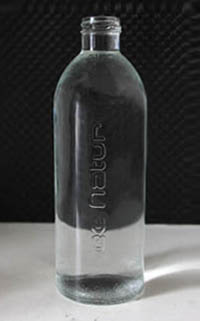Bottle bottom, joint line, measurement defects of glass bottle
2015-03-09
I. Bottle bottom defects
(1) Bottle bottom crack: Shallow crack in the bottom the bottle. Bottle bottom break: Deep cracks in any direction with radial in the bottom of bottle.
(2) Concave bottom: The bottom center is non-normal recessing. Convex bottom: the bottom center is bulging outward, when the bottles placed on the slab, the bottle will swing. Uneven bottom: Due to the bottom distortion, the bottle won’t stand firm on flat surface, it will swing.
(3) Mold bottom injury: Due to the bottom mold injury, the glass of the bottle bottom portion is bulging. Mold bottom line: Glass infiltrate the seam crossing of forming die and bottom die forming flaying spine for the bad cooperation of mold bottom.
(4) Bulkhead line is incorrect: Bulkhead line is not in the bottom center, it is partial to one side.
(5) Partial bottom: Bottle bottom interior is appeared oblique wave, but the inclination exceeds requirements. Generally, the ratio of partial bottom is controlled to 1: 2mm.
(6) Thin bottom: Insufficient glass in bottle bottom, its thickness can not achieve the design requirements, sometimes the partial bottom will lead to thin bottom.
II. The joint line defects
(1) A joint line crack (Break joint line): The vertical crack in forming die joint line. Its shape is different from hot mold crack.
(2) Bad original mold joint line: Bottle body iron bowl lines bulge and sharp. After molding, the original mold line was sunken. Forming die joint line burr: There is bulge flying spine in the forming die joint line, its shape is opposite to the original mold joint line. Forming die wrong seam: Bad cooperation of too half forming die, the joint line is appeared ladder shape.
(3) Bulkhead silk is too deep: The glass enters into the original mold and bulkhead pull seam form saw tooth line.
(4) Bottle mouth/Original mold joint line burr: It form bulging at the joint line of bottle mouth and iron bow.
III. Measurement defects
(1) Bottle body is too large: Bottle body diameter exceeds the standard limit. The bottle body sunken also lead to bottle body diameter is too large at some spot.
(2) The bottleneck blocking (narrow neck): Bottleneck inner diameter is smaller than the specified requirements.
(3) Bottle mouth inner diameter is too small: Bottle inner diameter is smaller than the specified requirements. It can be measured by plug guage or vernier caliper. Inner double mouth may cause mouth inner diameter is too small.
(4) Over height: Bottle height exceeds the standard limit, stretched bottleneck may cause bottle height exceed standard. Dwarf bottle: bottle height is less than the lower limit of the standard, bottle shrink too much or bottom seat will cause dwarf bottle.
(5) Bottle body is not round: The same initial test surface rotates 360 degree, the difference between long axis and minor axis exceeds the standard range of out-of-roundness. Bottle bulge: Bulge outward exceeds requirements.

(1) Bottle bottom crack: Shallow crack in the bottom the bottle. Bottle bottom break: Deep cracks in any direction with radial in the bottom of bottle.
(2) Concave bottom: The bottom center is non-normal recessing. Convex bottom: the bottom center is bulging outward, when the bottles placed on the slab, the bottle will swing. Uneven bottom: Due to the bottom distortion, the bottle won’t stand firm on flat surface, it will swing.
(3) Mold bottom injury: Due to the bottom mold injury, the glass of the bottle bottom portion is bulging. Mold bottom line: Glass infiltrate the seam crossing of forming die and bottom die forming flaying spine for the bad cooperation of mold bottom.
(4) Bulkhead line is incorrect: Bulkhead line is not in the bottom center, it is partial to one side.
(5) Partial bottom: Bottle bottom interior is appeared oblique wave, but the inclination exceeds requirements. Generally, the ratio of partial bottom is controlled to 1: 2mm.
(6) Thin bottom: Insufficient glass in bottle bottom, its thickness can not achieve the design requirements, sometimes the partial bottom will lead to thin bottom.
II. The joint line defects
(1) A joint line crack (Break joint line): The vertical crack in forming die joint line. Its shape is different from hot mold crack.
(2) Bad original mold joint line: Bottle body iron bowl lines bulge and sharp. After molding, the original mold line was sunken. Forming die joint line burr: There is bulge flying spine in the forming die joint line, its shape is opposite to the original mold joint line. Forming die wrong seam: Bad cooperation of too half forming die, the joint line is appeared ladder shape.
(3) Bulkhead silk is too deep: The glass enters into the original mold and bulkhead pull seam form saw tooth line.
(4) Bottle mouth/Original mold joint line burr: It form bulging at the joint line of bottle mouth and iron bow.
III. Measurement defects
(1) Bottle body is too large: Bottle body diameter exceeds the standard limit. The bottle body sunken also lead to bottle body diameter is too large at some spot.
(2) The bottleneck blocking (narrow neck): Bottleneck inner diameter is smaller than the specified requirements.
(3) Bottle mouth inner diameter is too small: Bottle inner diameter is smaller than the specified requirements. It can be measured by plug guage or vernier caliper. Inner double mouth may cause mouth inner diameter is too small.
(4) Over height: Bottle height exceeds the standard limit, stretched bottleneck may cause bottle height exceed standard. Dwarf bottle: bottle height is less than the lower limit of the standard, bottle shrink too much or bottom seat will cause dwarf bottle.
(5) Bottle body is not round: The same initial test surface rotates 360 degree, the difference between long axis and minor axis exceeds the standard range of out-of-roundness. Bottle bulge: Bulge outward exceeds requirements.
































